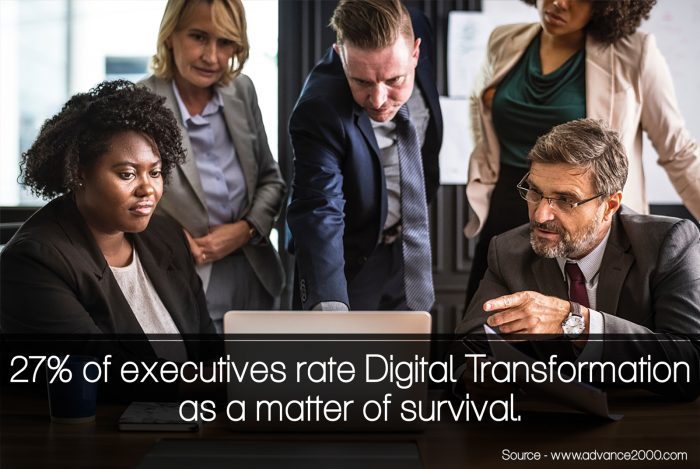
Image source – Licensed image from Envato
Digital transformation, like various other revolutions, is all about embracing change. The ‘change’ that is being referred is about acceptance of digital technology in every aspect of the business process. This is possible through the continual amalgamation of people with machines and information.
The process of Digital transformation evolves from the usage of digital technology, which itself develops from digital capability. Businesses that seek to utilize it to the fullest have to keep constantly innovating, and not just improve the existing traditional methods. So, when an organization decides to be digitally transformed, then it has to make full-fledged changes in every aspect of its business functions. Only when the entire system becomes ‘technology-driven,’ will it be able to call itself ‘digitally transformed.’
By following this process, organizations can achieve a comprehensive overhaul of their entire eco-system, which also includes the change in the consumer demand and even the competition. Moreover, by using it smartly, companies would be able to significantly decrease the costs, and be able to maximize their efficiency. Subsequently, it would enable them to deliver simplified and much more effective solutions to their clientele in the least possible time.

Digital technology has already turned into one of the primary disruptors in business today, and more and more firms are seeking out the benefits it offers. Digital transformation is inevitable, and it is happening in every industry. Disney Parks, Ford Motors, Domino’s, New York Times, Walmart, GE, Deloitte and the list could go on. Companies are placing the customer at the center of their business strategy. Each company uses a different approach to enhance the customer experience. However, companies that are managing the digital disruption effectively are ahead in the marketplace. Brands that have not adopted this new wave of revolution are either out of business or at the brink of it.
Digital transformation is one of the most challenging transformations for any business. It is the path of the future and a few companies failed while implementing the new digital model effectively. Many businesses drive the change without completely understanding the impact. One of the biggest mistakes that could be avoided is defining a clear objective. The leadership team should identify the opportunities and decide the business objectives.
Walmart is one of the best examples that identified the potential of the digital technology. The huge digital transformation investments in 2011 resulted in 150% online revenue growth between 2011-2014. Walmart has focused on providing a remarkable customer experience with the in-store experience, new mobile app features, optimized search engine, and, private cloud solution for data analysis.
So what Walmart did right that led them to a significant growth? To start with, they understood what their customers are precisely wanted. The change began at the top, and the leadership team has driven the digital initiatives. Walmart also combined social media and data analytics to provide a personalized experience. The leadership team built a company-wide digitally driven innovative culture.

Walmart’s success shows that any change that starts from the top leadership along with effective communication and the consistency across all the business verticals helps to achieve the required goals. The success of the transformation process depends hugely on strong leaders and their leadership. In this entire process, a strong leadership team is required to drive the change forward. Leaders should involve everyone in the organization in the transformation to avoid any pitfalls. Only when business leaders are able and willing to lead the cultural transition, they would be able to initiate and accomplish the radical change.
The decision makers have a vital role in helping their firms navigate the transition to the digital era. Harnessing the disruptive technologies to optimize the entire business flow requires persistent leadership, not just at the highest level, but at all levels of the organization. A cohesive leadership can redefine and thrust the business by perceiving the opportunities that can be utilized through the smart use of IT. However, as surprising as it may sound, digital leaders are not required to be the masters of technology.
Instead, their ability to communicate the commercial value of digital technologies is what matters. This is because the success of the transition is dependent on the leadership’s ability to commercialize the company’s digital strategy. Any business transformation is a long-term strategy and leaders should view this as an investment rather than the short-term expense. Here are some of the primary aspects through which strong leadership can affect the success of the process.

• Vision
Business leaders responsible for overseeing the transition are highly qualified. They possess the vision and the acumen that is necessary to lead the progress of the massive transition. Employees look up to them for support when this transition path becomes unclear. Leaders can see the ultimate destination and can guide them through.
• Engagement
The process of digital transformation mostly involves drastic cultural modifications within the organization. To make the vision of change a reality, employees have to be constantly engaged through motivation. C-level managers have the proficiency in drawing the staff together and keeping them motivated through the entire process. Making the journey as enjoyable and resourceful as the destination itself requires the tenacious capabilities of maturity of digital leaders.
• Strategy
Developing and adopting a comprehensive digital strategy is crucial to achieving success with digital change. Proficient leaders have the tactical aptitude to build a robust plan that can stand the ordeal of this extensive process. All business functions need the support of strategic leadership to carry out the transition smoothly.
• Collaboration
The sweeping changes that result from the transition impact the entire business. Organizations can find themselves starting fresh, while the employees would be required to perform new tasks they have never done before. Through proper collaboration, leaders can eliminate the resistance that can arise due to the overhaul. They can keep employees informed and set the right expectations. This would not just minimize the friction among the business functions but also between the employees and the technology they would be using.
As organizations need the digital transformation to survive and thrive in the digital era, the market worth of capable digital leaders has grown substantially. It is evident that digital transformation is about ideating a cohesive strategy. Furthermore, it also requires attracting, engaging and driving the right people towards a successful digital future. For this simple reason, every company needs the leaders with the right aptitude to guide it to success.



